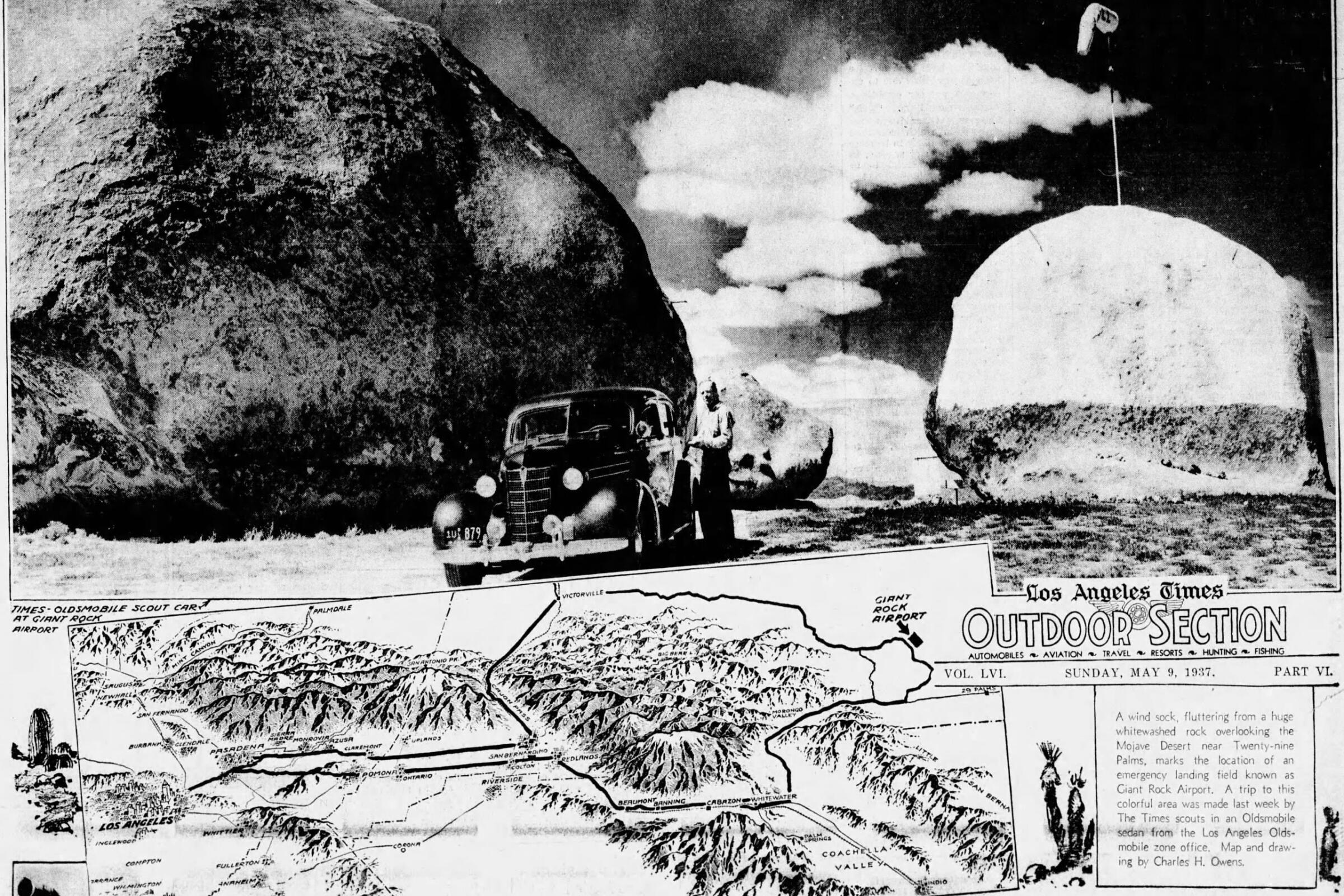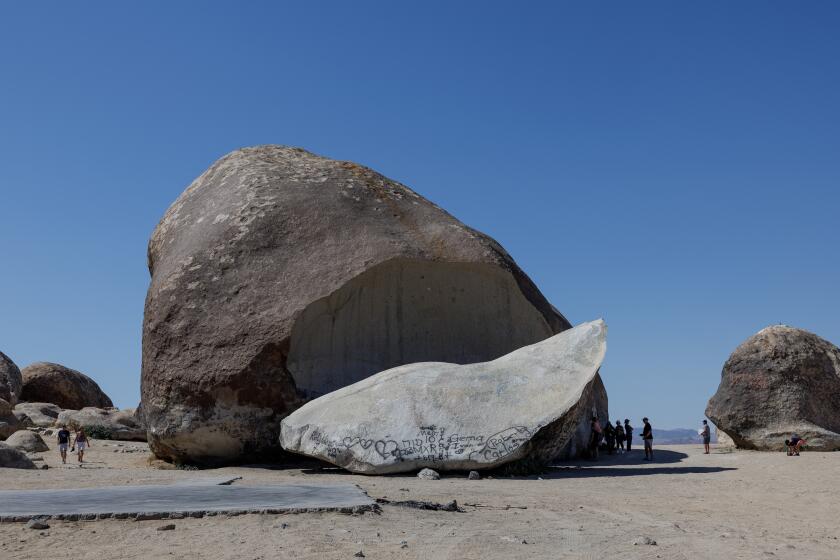Alex Wigglesworth is a reporter who covers the Inland Empire, Mojave Desert communities and the environment for the Los Angeles Times.
Here’s a timeline of key events at Giant Rock, a landmark north of Landers, Calif., that attracts seekers, partiers, conservationists and, according to some, extraterrestrials.
- Share via
1
Campers. Off-roaders. Ufologists.
Seekers of all stripes have been coming to Giant Rock, in the Mojave Desert just north of Landers, for a very long time.
“I just know there’s something majestic about that rock and that land, and it does draw people there,” says Michelle Anderson, an Orange County radio show host who recently hosted a tour of Giant Rock for attendees of Contact in the Desert, a UFO convention.
“Think about all that rock has endured in terms of humanity’s history. They say ‘if these walls could talk.’ If these rocks could talk, what would they tell us?”
Here are some of the highlights.
A seven-story boulder on federal land has become a tinderbox of tensions over who gets to enjoy this patch of Mojave Desert, which has rapidly gentrified since the COVID-19 pandemic.
2
1932: Making a rock a home
With squatter’s rights and a mining claim, prospector Frank Critzer moves to Giant Rock, reportedly using dynamite to excavate a living room and bedroom and constructing a windowed wall beneath the rock overhang. The 60-foot-thick granite roof regulates the temperature so the home stays cool in the summer and warm in the winter.
Critzer gets to work digging roads and building an airport.
The Times reports the eccentric self-described hermit also “had a standing offer to recharge flashlight batteries by putting them under his pillow at night: “I’m so full of electricity you might as well get your flashlights recharged for nothing,’ he used to say,” according to a report published in 1942.

A Times story in 1937 chronicled Frank Critzer’s efforts to build a home under Giant Rock in the Mojave Desert. The article made a point of saying that an Oldsmobile helped make the trip from L.A. to the desert.
(Los Angeles Times Archive / Newspapers.com)
3
1937: Development continues
The Times sends outdoor editor Lynn J. Rogers to visit Critzer at Giant Rock.
“If you travel by auto rather than by air, you may visit him easily, for he has built thirty-three miles of the straightest desert road that anybody ever saw,” Rogers reports. “Not a wealthy man’s hobby, either, for Frank has accomplished it all in five year’s time with an original capital of five dollars, and for tools a twenty year old automobile, a grubbing hoe, shovel, pair of binoculars and three wooden stakes.”
Critzer tells Rogers that he dreams of someday opening “a little winter resort” there.
4
1938: Officials grow skeptical
Critzer’s airport comes under scrutiny. Though it’s well-known in the area, The Times reports that federal authorities are investigating it “as a carefully concealed mystery airport.”
“The reports were that the airport, tucked away in a valley in the desert mountain ranges, had underground living quarters for pilots and a hidden hangar in a cave in a cliff. The airport was said to have been camouflaged to conceal it from flyers and from residents of the region.”
A Times report written several years later notes that by 1942, “with the United States beset by both Japan and Germany, the Army was jittery about isolated landing fields.”
“Rumors circulated that somewhere in the desert the Japanese might try to refuel suicide planes from submarines in the Gulf of California and bomb the power plant at Hoover Dam and thus cripple the airplane manufacturing industry of Southern California.”
5
1942: Violence at Giant Rock
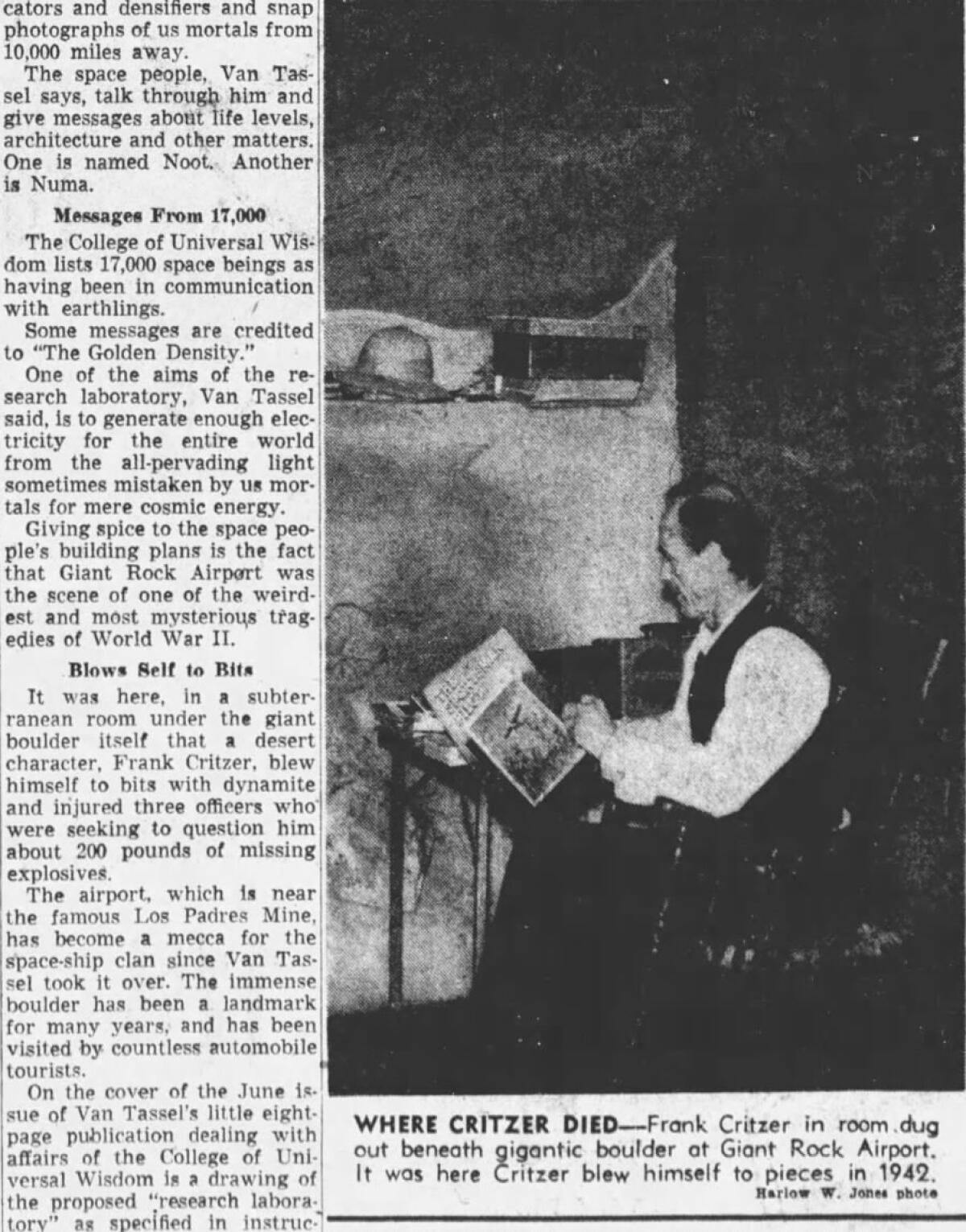
A 1954 clipping of a Times article shows Frank Critzer in his underground home at Giant Rock. At the time, the paper called Critzer’s death “one of the weirdest and most mysterious tragedies of World War II.”
(Los Angeles Times Archive / Newspapers.com)
Critzer dies at 57 in an explosion at Giant Rock that injures three Riverside County sheriff’s deputies.
The Times reports the deputies were seeking to question Critzer in connection with the thefts of gasoline or explosives from locations in Garnet, Banning and Palm Springs. As they enter his cave, he yells, “You’re not taking me out of here alive. I’m going, but another way, and you’re going with me,” and detonates a stockpile of dynamite, according to that report.
Others would later speculate the dynamite had ignited when the deputies threw smoke canisters under the rock in an attempt to flush Critzer out.
Subsequent reports, including those published in The Times, indicate that Critzer may have come under scrutiny because, amid the panic of World War II, authorities had suspected him as a spy — he had a German name, he’d built an isolated landing field, and he’d affixed a large antenna atop the rock that brought in radio stations from all over the world.
6
1947: A new resident
George Van Tassel, aviation engineer and test pilot, moves to Giant Rock with his wife and children. He’d become acquainted with Critzer and had visited him at Giant Rock when he was still alive.
Van Tassel takes over operation of the airport. He and his wife open a small cafe, the Come On Inn, where Eva Van Tassel cooks hamburgers and bakes pie.
Contact in the Desert melds a fascination with Ufology, esoteric spirituality, government conspiracy, alt-celebrity culture and a bit of self-awareness.
7
1953: An otherworldly visitor
Van Tassel begins conducting weekly meditation sessions at Giant Rock during which he claims to communicate telepathically with extraterrestrials, channeling their messages through his vocal chords.
One night, he says he’s awoken by a being from Venus who levitates him aboard a spacecraft and gives him a formula to build an antigravity time machine that can inhibit aging.
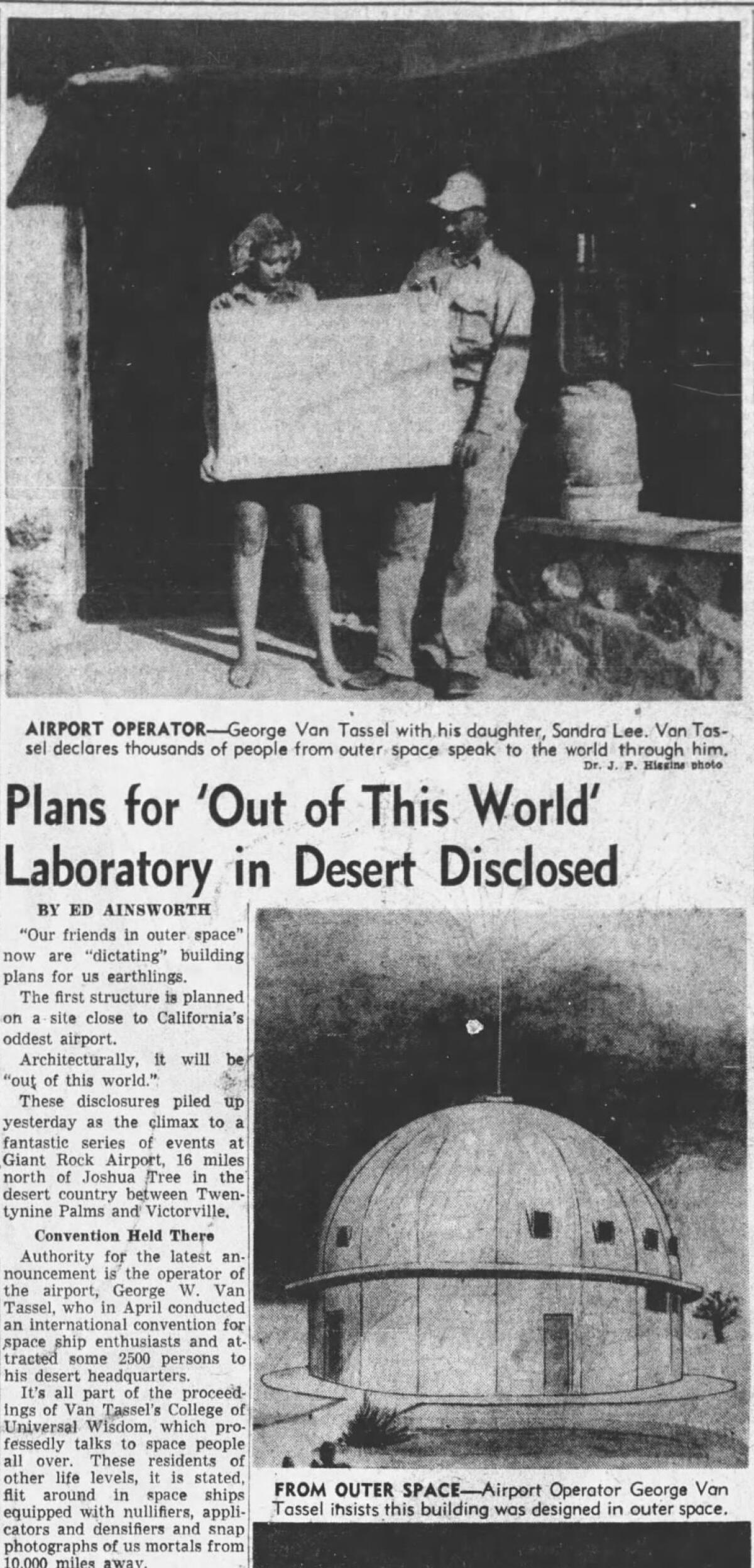
A 1954 Times story didn’t take George Van Tassel’s claims very seriously. One paragraph reads: “The space people, Van Tassel says, talk through him and give messages about life levels, architecture and other matters. One is named Noot. Another is Numa.”
(Los Angeles Times Archive / Newspapers.com)
He founds the College of Universal Wisdom, which at one point maintained a list of some 17,000 space beings who’d been in communication with humans, and begins to hold yearly spacecraft conventions at Giant Rock.
The Times reported of one such convention, in 1955:
“Joining [Van Tassel] as sponsors were a number of men and women who have written books about spaceships or are going to do so as quickly as possible. They nearly all sounded some dire warnings for earthlings, but threw in a little hope, too, if we wake up and listen to what friendly space beings are telling us to do.”
“... One man who was going around with a Geiger counter said that even the air around Giant Rock was jumping with cosmic rays of leftover clouds from the Nevada atom blast, or backwash from space ships. Anyway, everybody was on the lookout for a space craft to come in and land.”
In later years, the convention featured, interspersed with speakers, parachute jumping and stuntmen doing acrobatics on rope ladders beneath airplanes, according to The Times.
8
1957: The beginnings of the Integratron
Van Tassel breaks ground on the machine he says the extraterrestrials instructed him to build, which he also describes as a research laboratory. (The Times reports that one of its goals is to “generate enough electricity for the entire world from the all-pervading light sometimes mistaken by us mortals for mere cosmic energy.”)
The dome-shaped building of laminated plywood is designed to have no metal — no screws, no nails — and a cement ring called the oculus holding down the arches that form its structure.
A Los Angeles architect who drew up the plans tells The Times in 1954 that he isn’t sure whether he’d received inspiration from extraterrestrials. “I can’t say whether some original ideas I incorporated in it were strictly mine or ‘inspired,’ as some people say,” says Howard P. Hess. “The universe is too big for me to pretend I know everything.”
The construction is financed by donations solicited in newsletters distributed at Van Tassels’ annual spacecraft conventions.
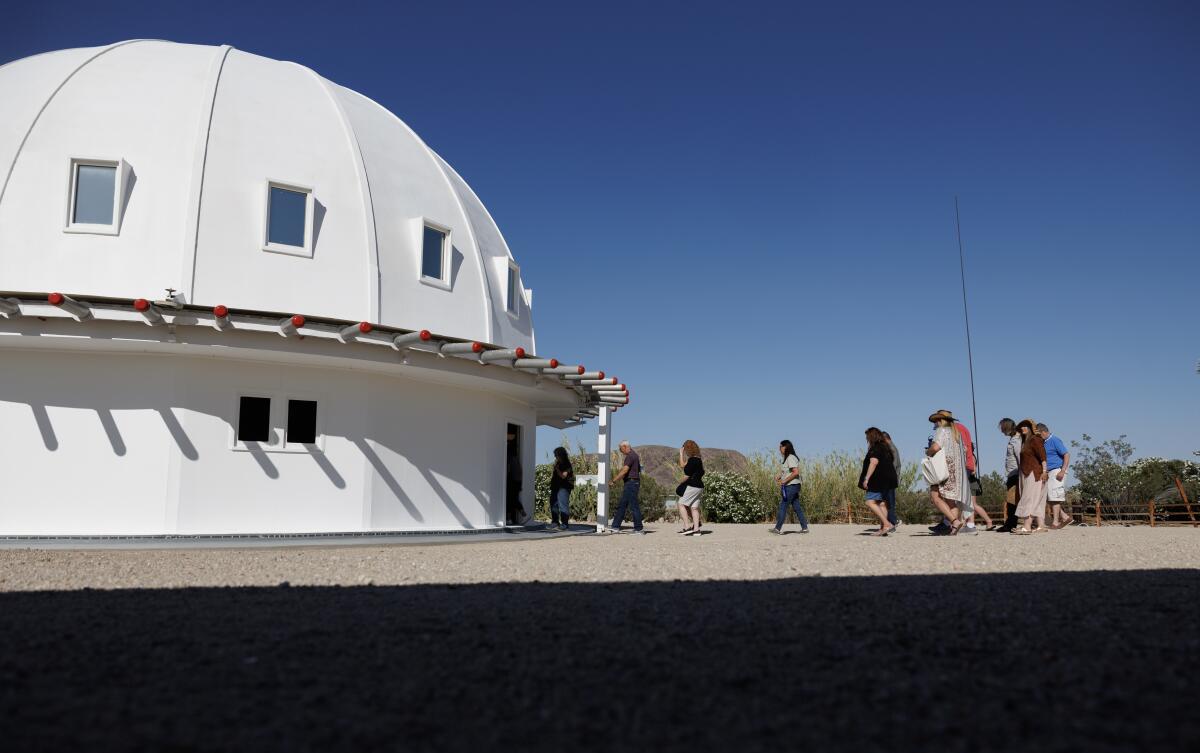
A group from Contact in the Desert enters the Integratron in May.
(Gina Ferazzi / Los Angeles Times)
9
1978: Second resident dies
Van Tassel dies unexpectedly. Work on the Integratron is incomplete: Although the dome is built, the machine itself is unfinished. Van Tassel’s widow later puts it up for sale.
L.A. is the unofficial sound bath capital of the U.S. Here are the 11 best to try, for every type of person.
10
2000: Gravity and prophecy
A chunk of Giant Rock splits from the main boulder in an event that has no known witnesses and no certain cause. Some have speculated heat stress from bonfires that often burn beneath it could be to blame.
In the days before the split, a group had visited the rock to perform a durational dance ceremony led by Shri Naath Devi, a South Los Angeles spiritual healer also known as Mataji. Devi reportedly relayed a prophecy of unknown origin — the rock would break apart in one of two ways: Down the middle, humanity was facing extinction. At its side, people still had a chance.
“What Mataji relayed to me was that her understanding of the prophecy was that humanity would be facing a choice,” says Anderson, who met the healer before her death in 2022. “Are we going to continue being the beautiful humans that is our divine personal blueprint? Or are we going to exterminate ourselves?”
The day after the ceremony concluded, a large hunk of Giant Rock cleaved off. It had split at its side.

Giant Rock in May 2024.
(Gina Ferazzi / Los Angeles Times)
